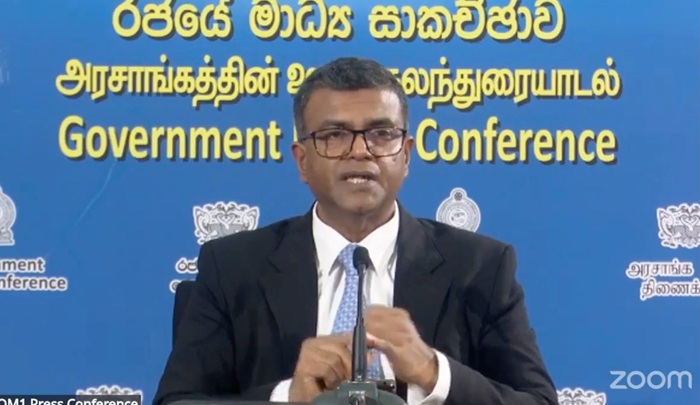
Secretary to the Ministry of Finance Dr. Harsha Suriyapperuma said the reduction of the United States tariff rate on Sri Lankan exports to 20% marked progress toward one of the country’s key trade objectives.
“The primary goal was to determine how Sri Lanka could move forward while preserving its competitive position in the regional market,” he said, adding that the focus was not solely on the tariff percentage but on maintaining market share for Sri Lankan exporters of goods and services.
Suriyapperuma made these observations during a government media briefing to announce the reduced tariff rate on Sri Lankan exports to the United States to 20%, calling it a significant outcome of recent trade negotiations
He said that ensuring continued competitiveness for exporters and entrepreneurs was central to the negotiations.
Suriyapperuma said the government aimed to open the domestic market in ways that would generate mutual benefits for both countries. The talks were guided by a broader economic strategy focused on facilitating not only the trade of goods but also the transfer of knowledge and technology to support long-term growth.
He added that the government consistently assessed the impact on local industries and remained committed to safeguarding critical sectors while expanding trade access.
What did Sri Lanka offer?
Sri Lanka positioned itself as a net importer of energy, raw materials, and advanced machinery—products largely sourced for industrial and consumer use, Suriyapperuma said.
Sri Lanka’s offer to the US involved providing market access on a non-discriminatory, competitive basis, particularly for private US suppliers, rather than through direct government-to-government agreements.
He added that discussions focused on minimizing both tariffs and para-tariffs, with trade facilitation identified as a major component of the offer. This included commitments to improve customs procedures through a national single window system, increase transparency, and reduce bureaucratic delays at border agencies—steps aimed at lowering the cost of doing business in Sri Lanka.
The trade proposal extended beyond individual product lines and included reforms consistent with the economic framework under Sri Lanka’s current IMF-supported program.
“Our offer is comprehensive,” Dr. Suriyapperuma said, “factoring in market access and the ease of doing business. We expect both foreign and domestic businesses to benefit.”
Key issues identified in talks
On labour law concerns—particularly in the apparel sector— Suriyapperuma said that the trade discussions were broad-based, centred on improving market access for local entrepreneurs and reducing production costs through technological upgrades. He affirmed that all relevant government agencies had been briefed and that no sector was excluded from consideration.
When asked about potential changes to intellectual property laws, quotas on imports such as oil or agricultural inputs, or broader trade concessions, he said that while some details remain confidential due to the nature of the negotiations, Sri Lanka has maintained transparency where possible.
He confirmed that Sri Lanka’s energy imports were part of the talks, with the aim of achieving more competitive pricing. Trade facilitation was also presented as a solution to the longstanding challenges faced by local exporters.
Will the government renegotiate with the IMF?
Responding to questions on whether the trade discussions could trigger a need to renegotiate terms with the IMF, Dr. Suriyapperuma said Sri Lanka continues to operate within agreed parameters. He added that any necessary adjustments would be discussed with all stakeholders, and that the government is working in coordination with multilateral partners and the business community.
“This is a collective effort,” he said. “We are committed to making Sri Lanka more competitive while fulfilling our international obligations.”
Suriyapperuma also expressed appreciation to officials involved in the process, including Central Bank Governor Dr. Nandalal Weerasinghe, Presidential Economic Adviser Duminda Hulangamuwa, Secretary to the Ministry of Trade Wimalendra Raja, and Sri Lanka’s Ambassador to the US Mahinda Samarasinghe. (Newswire)
